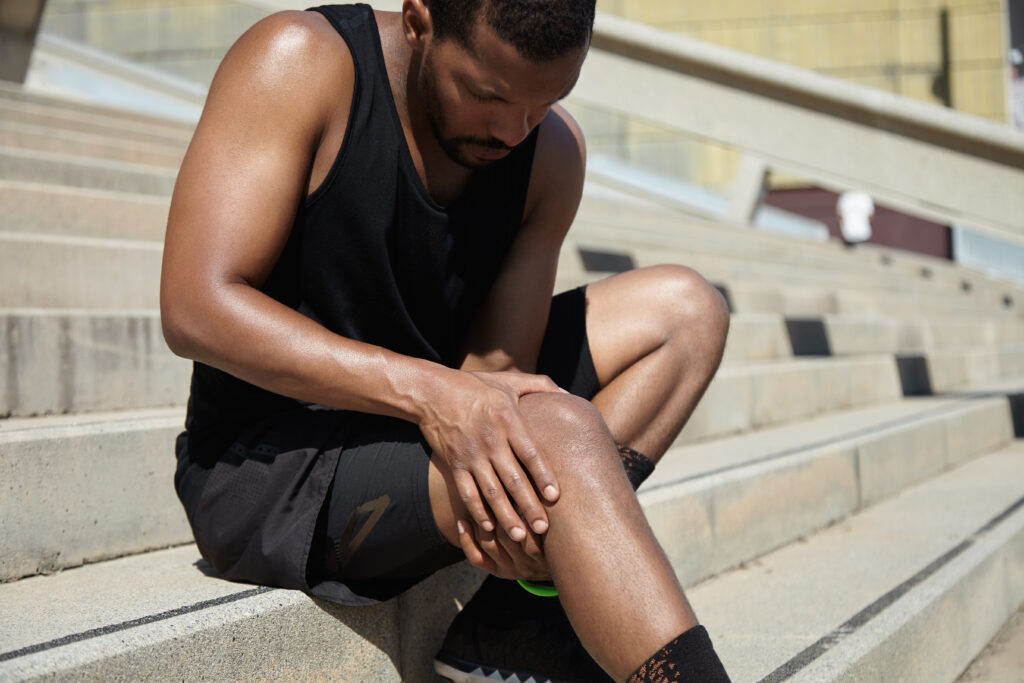When you're dealing with a sports injury, knowing the best treatments can make all the difference in your recovery. You might find that rest and ice are just the starting points, but what about the role of physical therapy or alternative treatments like acupuncture? Understanding how each method contributes to your healing process is essential for getting back to your game. There's a variety of options to explore, and some might surprise you in their effectiveness. What might work best for you could be just around the corner.
Rest and Recovery
Rest and recovery are essential components in the healing process for sports injuries. When you push your body during physical activity, it occasionally results in strains, sprains, or more severe injuries. Giving your body time to rest is vital for healing and preventing further damage. It's tempting to jump back in as soon as you feel a bit better, but that can often lead to more complications.
During your recovery phase, listen to your body. If you're feeling pain, that's your cue to slow down. Engaging in light activities, like walking or gentle stretching, can help maintain some level of fitness while you heal, but avoid any high-impact movements that could exacerbate your injury. Communicating with your healthcare provider about your pain levels and progress can also guide your recovery.
Setting a timeline for rest can be beneficial. Depending on the severity of your injury, you might need days to weeks of downtime. Use this time wisely—focus on nutrition, hydration, and sleep, as these elements play a significant role in recovery. Consider incorporating mindfulness or relaxation techniques to help manage any frustration from being sidelined.
Finally, when you're ready to return to your sport, ease back in gradually. Starting with lower intensity and frequency will help your body adjust. By prioritizing rest and recovery, you're investing in your long-term health and performance, ensuring you're not only back on your feet but ready to perform at your best.
Ice and Compression
After giving your body adequate time to rest, it's important to incorporate ice and compression into your recovery routine. These methods can greatly reduce inflammation, alleviate pain, and promote faster healing.
When you experience a sports injury, applying ice helps constrict blood vessels, which minimizes swelling and numbs the area, providing relief from discomfort. Aim to ice the injured area for 15-20 minutes every hour, especially during the first 48 hours.
Compression plays an essential role, too. Using an elastic bandage or a compression wrap can help support the injured area while further reducing swelling. Make sure not to wrap it too tightly, as this could restrict circulation.
Here are some key benefits to using ice and compression:
- Reduces inflammation: Helps prevent excess swelling after an injury.
- Relieves pain: Numbs the affected area, making it easier to manage discomfort.
- Improves mobility: As swelling decreases, you may regain movement more quickly.
- Speeds up recovery: Together, these methods promote faster healing, allowing you to return to your sport sooner.
Incorporating ice and compression into your recovery routine can make a considerable difference in how quickly you bounce back from an injury.
Physical Therapy
Physical therapy plays an essential role in your recovery journey after a sports injury. It's more than just rehabilitation; it's about regaining strength, flexibility, and functionality. When you visit a physical therapist, they'll assess your injury and develop a tailored plan that addresses your specific needs. This personalized approach guarantees you get the most effective treatment possible.
During your sessions, you'll engage in various exercises designed to improve your range of motion and strengthen the affected area. Your therapist will guide you through each movement, ensuring you're using the correct technique to avoid further injury. They might also employ modalities like ultrasound or electrical stimulation to enhance healing and reduce inflammation, giving you a thorough recovery experience.
One of the key benefits of physical therapy is education. Your therapist will teach you about your injury, helping you understand the underlying causes and the importance of proper body mechanics during activities. This knowledge empowers you to prevent future injuries and make informed decisions about your training.
As you progress, your therapist will adjust your program to challenge you appropriately, ensuring you're not only recovering but also improving your overall athletic performance.
Consistency is essential, so sticking to your therapy schedule is important for best results. Remember, the goal of physical therapy isn't just about recovery; it's about returning to your sport stronger and more resilient than before. Embrace the journey, and you'll reap the rewards.
Pain Relief Medications
When you're dealing with a sports injury, finding effective pain relief is essential for your recovery.
You've got options like over-the-counter medications and prescription pain relievers to evaluate.
Understanding how each type works can help you choose the best approach for managing your pain.
Over-the-Counter Options
Often, athletes and active individuals turn to over-the-counter (OTC) pain relief medications to manage sports-related injuries effectively.
These medications can provide quick relief from pain and inflammation, allowing you to get back to your routine sooner. When considering OTC options, it's crucial to choose wisely based on your specific needs.
Here are some common OTC pain relief medications you might consider:
- Nonsteroidal Anti-Inflammatory Drugs (NSAIDs): Medications like ibuprofen and naproxen can reduce pain and inflammation.
- Acetaminophen: This is a good option for pain relief if you're sensitive to NSAIDs or have certain health concerns.
- Topical Analgesics: Creams or patches containing menthol or capsaicin can provide localized relief without affecting the whole body.
- Combination Products: Some medications combine different active ingredients to target pain in multiple ways.
Prescription Pain Relievers
If over-the-counter options aren't providing the relief you need, prescription pain relievers may be the next step in managing your sports injury. These medications can effectively reduce pain and inflammation, helping you return to your favorite activities faster.
Common prescription pain relievers include stronger nonsteroidal anti-inflammatory drugs (NSAIDs) and opioids, depending on the severity of your injury.
Before starting any prescription medication, it's important to consult with your healthcare provider. They'll assess your condition and determine the most appropriate treatment plan tailored to your needs.
They can also discuss potential side effects and interactions with other medications you might be taking.
While prescription pain relievers can be effective, it's vital to use them responsibly. Follow your doctor's instructions carefully and avoid increasing dosages without guidance.
Additionally, consider pairing your medication with other treatments, such as physical therapy, to promote healing and regain strength.
Massage Therapy
Massage therapy offers a range of benefits that can greatly aid your recovery from sports injuries.
By exploring various techniques tailored for injury rehabilitation, you can enhance your healing process.
It's also essential to understand the recommended frequency and duration for effective treatment.
Benefits of Massage Therapy
Numerous studies highlight the benefits of massage therapy in treating sports injuries, making it a popular choice among athletes.
When you incorporate massage into your recovery routine, you'll likely notice significant improvements in your overall performance and well-being.
Here are some key benefits of massage therapy:
- Enhanced Circulation: Massage increases blood flow, which helps deliver essential nutrients to injured tissues, promoting healing.
- Reduced Muscle Tension: It alleviates tightness in your muscles, allowing for greater flexibility and a wider range of motion.
- Pain Relief: Regular massage can decrease pain levels by triggering the release of endorphins, your body's natural painkillers.
- Improved Recovery Time: By aiding in muscle repair and reducing inflammation, massage can shorten the time it takes for you to bounce back from injuries.
Incorporating massage therapy into your training regimen can be a game-changer.
Whether you're dealing with a specific injury or just looking to maintain your overall health, this holistic approach can help you perform at your best and keep you in the game longer.
Techniques for Injury Recovery
After exploring the benefits of massage therapy, it's important to understand the specific techniques that can enhance injury recovery.
One effective method is deep tissue massage. This technique targets deeper layers of muscle and connective tissue, helping to alleviate tension and promote healing in injured areas. By applying firm pressure, it can break up scar tissue and improve blood circulation, which is essential for recovery.
Another valuable technique is trigger point therapy. This approach focuses on specific areas of tightness, known as trigger points, that can cause pain and hinder your movement. By applying pressure and releasing these points, you can experience considerable relief and increased range of motion.
Sports massage is also beneficial, as it combines various techniques tailored to your specific sport and injury. This type of massage can help reduce muscle soreness, improve flexibility, and prepare your body for athletic performance.
Lastly, lymphatic drainage massage can support recovery by stimulating the lymphatic system, aiding in the removal of toxins and reducing swelling.
Utilizing these techniques can greatly enhance your injury recovery process, allowing you to return to your favorite activities sooner.
Frequency and Duration Guidelines
How often should you schedule massage therapy sessions during your injury recovery? The frequency and duration of your sessions can greatly impact how quickly you heal. Generally, it's recommended to start with more frequent sessions, especially in the initial stages of recovery. You might consider scheduling massages 1-2 times per week, gradually decreasing as you progress.
Here are some key guidelines to keep in mind:
- Listen to Your Body: Pay attention to how your body responds. If the pain persists, consider increasing the frequency.
- Consult a Professional: A massage therapist can provide personalized recommendations based on your specific injury and needs.
- Adjust as You Heal: As your condition improves, you can reduce the frequency to maintain flexibility and prevent future injuries.
- Combine With Other Treatments: Integrating massage therapy with other rehabilitation methods can enhance overall recovery.
Alternative Treatments
While traditional methods like rest and physical therapy are effective for many sports injuries, alternative treatments offer unique approaches that can enhance recovery. One popular option is acupuncture, which involves inserting thin needles into specific points on your body. This ancient practice can help reduce pain and inflammation, promoting healing by improving circulation and releasing endorphins.
Another alternative treatment you might consider is chiropractic care. Chiropractors focus on aligning your spine and joints, which can alleviate pain and improve your range of motion. Many athletes find that regular adjustments help prevent injuries and maintain peak performance.
You could also explore the benefits of massage therapy. Sports massage targets muscle groups that are overworked or strained, helping to alleviate tension and improve flexibility. This hands-on approach can aid recovery by increasing blood flow and reducing soreness after workouts or competitions.
Herbal remedies are yet another option. Certain herbs, like arnica or turmeric, have anti-inflammatory properties that can help reduce pain and swelling. However, it's important to consult with a healthcare professional before adding any supplements to your routine.
Lastly, consider incorporating practices like yoga or tai chi into your regimen. These mind-body techniques promote flexibility, strength, and balance, all of which are vital for injury prevention and recovery.
Surgical Options
If alternative treatments aren't providing the relief you need, surgical options may be worth considering for more severe sports injuries. When faced with persistent pain, mobility issues, or a diagnosis that can't be managed non-surgically, it's vital to explore surgical interventions.
These procedures can address structural problems in your body, helping you return to your sport more quickly and effectively.
Here are some common surgical options for sports injuries:
- Arthroscopy: A minimally invasive procedure that allows your doctor to diagnose and treat joint problems, often resulting in shorter recovery times.
- Ligament Reconstruction: This surgery repairs or reconstructs torn ligaments, commonly performed on knees (like ACL repairs) to restore stability.
- Tendon Repair: If you've torn a tendon, surgical repair can restore function and strength, allowing you to regain your range of motion.
- Joint Replacement: For severe joint damage, replacing a joint can alleviate pain and improve mobility, especially in hips and knees.
Before deciding on surgery, consult with your healthcare provider to weigh the benefits and risks. They'll help you understand the procedure, recovery time, and rehabilitation process.
While surgery can be a significant step, it might just be the solution you need to get back to the sports you love, pain-free and stronger than before. Always remember, a well-informed decision is vital to your recovery journey.
Conclusion
In summary, finding the right treatment for your sports injury is essential for a quick recovery. By incorporating rest, ice, and compression, along with physical therapy and pain relief medications, you can effectively manage your symptoms. Don't overlook the benefits of massage therapy and alternative treatments to enhance your healing process. In severe cases, surgical options might be necessary. Remember, a tailored approach will help you return to your favorite activities safely and effectively.



